+ Open data
Open data
- Basic information
Basic information
| Entry | Database: EMDB / ID: EMD-4176 | ||||||||||||
|---|---|---|---|---|---|---|---|---|---|---|---|---|---|
| Title | Polytomella Fo model | ||||||||||||
 Map data Map data | |||||||||||||
 Sample Sample |
| ||||||||||||
 Keywords Keywords | electron cryo-microscopy mitochondrial ATP synthase membrane protein energy conversion proton pathway / PROTON TRANSPORT | ||||||||||||
| Function / homology |  Function and homology information Function and homology informationproton transmembrane transporter activity / proton motive force-driven ATP synthesis / proton-transporting two-sector ATPase complex, proton-transporting domain / proton-transporting ATP synthase complex / proton-transporting ATP synthase activity, rotational mechanism / lipid binding / mitochondrion Similarity search - Function | ||||||||||||
| Biological species |  Polytomella sp. Pringsheim 198.80 (plant) Polytomella sp. Pringsheim 198.80 (plant) | ||||||||||||
| Method | single particle reconstruction / cryo EM / Resolution: 3.7 Å | ||||||||||||
 Authors Authors | Yildiz O / Kuehlbrandt W | ||||||||||||
| Funding support |  Germany, 3 items Germany, 3 items
| ||||||||||||
 Citation Citation |  Journal: Elife / Year: 2017 Journal: Elife / Year: 2017Title: Structural basis of proton translocation and force generation in mitochondrial ATP synthase. Authors: Niklas Klusch / Bonnie J Murphy / Deryck J Mills / Özkan Yildiz / Werner Kühlbrandt /  Abstract: ATP synthases produce ATP by rotary catalysis, powered by the electrochemical proton gradient across the membrane. Understanding this fundamental process requires an atomic model of the proton ...ATP synthases produce ATP by rotary catalysis, powered by the electrochemical proton gradient across the membrane. Understanding this fundamental process requires an atomic model of the proton pathway. We determined the structure of an intact mitochondrial ATP synthase dimer by electron cryo-microscopy at near-atomic resolution. Charged and polar residues of the -subunit stator define two aqueous channels, each spanning one half of the membrane. Passing through a conserved membrane-intrinsic helix hairpin, the lumenal channel protonates an acidic glutamate in the -ring rotor. Upon ring rotation, the protonated glutamate encounters the matrix channel and deprotonates. An arginine between the two channels prevents proton leakage. The steep potential gradient over the sub-nm inter-channel distance exerts a force on the deprotonated glutamate, resulting in net directional rotation. | ||||||||||||
| History |
|
- Structure visualization
Structure visualization
| Movie |
 Movie viewer Movie viewer |
|---|---|
| Structure viewer | EM map:  SurfView SurfView Molmil Molmil Jmol/JSmol Jmol/JSmol |
| Supplemental images |
- Downloads & links
Downloads & links
-EMDB archive
| Map data |  emd_4176.map.gz emd_4176.map.gz | 905.1 KB |  EMDB map data format EMDB map data format | |
|---|---|---|---|---|
| Header (meta data) |  emd-4176-v30.xml emd-4176-v30.xml emd-4176.xml emd-4176.xml | 16.4 KB 16.4 KB | Display Display |  EMDB header EMDB header |
| Images |  emd_4176.png emd_4176.png | 218.5 KB | ||
| Filedesc metadata |  emd-4176.cif.gz emd-4176.cif.gz | 6 KB | ||
| Archive directory |  http://ftp.pdbj.org/pub/emdb/structures/EMD-4176 http://ftp.pdbj.org/pub/emdb/structures/EMD-4176 ftp://ftp.pdbj.org/pub/emdb/structures/EMD-4176 ftp://ftp.pdbj.org/pub/emdb/structures/EMD-4176 | HTTPS FTP |
-Validation report
| Summary document |  emd_4176_validation.pdf.gz emd_4176_validation.pdf.gz | 301.7 KB | Display |  EMDB validaton report EMDB validaton report |
|---|---|---|---|---|
| Full document |  emd_4176_full_validation.pdf.gz emd_4176_full_validation.pdf.gz | 301.3 KB | Display | |
| Data in XML |  emd_4176_validation.xml.gz emd_4176_validation.xml.gz | 7.3 KB | Display | |
| Data in CIF |  emd_4176_validation.cif.gz emd_4176_validation.cif.gz | 8.6 KB | Display | |
| Arichive directory |  https://ftp.pdbj.org/pub/emdb/validation_reports/EMD-4176 https://ftp.pdbj.org/pub/emdb/validation_reports/EMD-4176 ftp://ftp.pdbj.org/pub/emdb/validation_reports/EMD-4176 ftp://ftp.pdbj.org/pub/emdb/validation_reports/EMD-4176 | HTTPS FTP |
-Related structure data
| Related structure data | 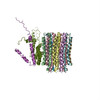 6f36MC M: atomic model generated by this map C: citing same article ( |
|---|---|
| Similar structure data |
- Links
Links
| EMDB pages |  EMDB (EBI/PDBe) / EMDB (EBI/PDBe) /  EMDataResource EMDataResource |
|---|---|
| Related items in Molecule of the Month |
- Map
Map
| File |  Download / File: emd_4176.map.gz / Format: CCP4 / Size: 421.9 MB / Type: IMAGE STORED AS FLOATING POINT NUMBER (4 BYTES) Download / File: emd_4176.map.gz / Format: CCP4 / Size: 421.9 MB / Type: IMAGE STORED AS FLOATING POINT NUMBER (4 BYTES) | ||||||||||||||||||||||||||||||||||||||||||||||||||||||||||||
|---|---|---|---|---|---|---|---|---|---|---|---|---|---|---|---|---|---|---|---|---|---|---|---|---|---|---|---|---|---|---|---|---|---|---|---|---|---|---|---|---|---|---|---|---|---|---|---|---|---|---|---|---|---|---|---|---|---|---|---|---|---|
| Projections & slices | Image control
Images are generated by Spider. | ||||||||||||||||||||||||||||||||||||||||||||||||||||||||||||
| Voxel size | X=Y=Z: 1.105 Å | ||||||||||||||||||||||||||||||||||||||||||||||||||||||||||||
| Density |
| ||||||||||||||||||||||||||||||||||||||||||||||||||||||||||||
| Symmetry | Space group: 1 | ||||||||||||||||||||||||||||||||||||||||||||||||||||||||||||
| Details | EMDB XML:
CCP4 map header:
| ||||||||||||||||||||||||||||||||||||||||||||||||||||||||||||
-Supplemental data
- Sample components
Sample components
-Entire : Polytommella mitochondrial ATP synthase Fo complex
| Entire | Name: Polytommella mitochondrial ATP synthase Fo complex |
|---|---|
| Components |
|
-Supramolecule #1: Polytommella mitochondrial ATP synthase Fo complex
| Supramolecule | Name: Polytommella mitochondrial ATP synthase Fo complex / type: complex / ID: 1 / Parent: 0 / Macromolecule list: all |
|---|---|
| Source (natural) | Organism:  Polytomella sp. Pringsheim 198.80 (plant) Polytomella sp. Pringsheim 198.80 (plant) |
| Molecular weight | Theoretical: 110 KDa |
-Macromolecule #1: Mitochondrial ATP synthase subunit c
| Macromolecule | Name: Mitochondrial ATP synthase subunit c / type: protein_or_peptide / ID: 1 / Number of copies: 10 / Enantiomer: LEVO |
|---|---|
| Source (natural) | Organism:  Polytomella sp. Pringsheim 198.80 (plant) Polytomella sp. Pringsheim 198.80 (plant) |
| Molecular weight | Theoretical: 12.664013 KDa |
| Sequence | String: MSVQRLSLGA ARCLSAGVAR VQASQALVAQ KAVAVAPTRA QAAPAEVAQV RSMSVLAASK MVGAGCATIA LAGVGAGLGV MFGSLINGA ARNPNIAKQL VGYALLGFAL TESIALFSLL VVFLILFA UniProtKB: Mitochondrial ATP synthase subunit c |
-Macromolecule #2: Mitochondrial ATP synthase subunit 6
| Macromolecule | Name: Mitochondrial ATP synthase subunit 6 / type: protein_or_peptide / ID: 2 / Number of copies: 1 / Enantiomer: LEVO |
|---|---|
| Source (natural) | Organism:  Polytomella sp. Pringsheim 198.80 (plant) Polytomella sp. Pringsheim 198.80 (plant) |
| Molecular weight | Theoretical: 34.802344 KDa |
| Sequence | String: MSVLSSVSMG SRIGSSLLGR SSAYLAQCGF STRSNLNGSI DTSSSVFQAL SSDNENKPAA SPLNVKLPGM SCSSILLPKT SRIAVPFGN QTMAMSSVRD VKTGSLPTNF LTGVYRFWRS QNPAEKPHDP VNDRLLPAVV DASDKRASIG TWATTFFCTI I SCNLLGLM ...String: MSVLSSVSMG SRIGSSLLGR SSAYLAQCGF STRSNLNGSI DTSSSVFQAL SSDNENKPAA SPLNVKLPGM SCSSILLPKT SRIAVPFGN QTMAMSSVRD VKTGSLPTNF LTGVYRFWRS QNPAEKPHDP VNDRLLPAVV DASDKRASIG TWATTFFCTI I SCNLLGLM PFNEAPTSGL GFATGLGVSV WATATILGLS KTGFKFPGHF IPGGTPWPMA FIFVPLETIS YTFRAVSLGV RL WVNMLAG HTLLHILTGM ALALPFSLGF FSMVPATFGV CCLLSALVGL EYLVAVLQSG VFSILSTVYV GEFNHDKFIG PAA KIVKKI H UniProtKB: F-ATPase protein 6 |
-Macromolecule #3: Mitochondrial ATP synthase subunit ASA6
| Macromolecule | Name: Mitochondrial ATP synthase subunit ASA6 / type: protein_or_peptide / ID: 3 / Number of copies: 1 / Enantiomer: LEVO |
|---|---|
| Source (natural) | Organism:  Polytomella sp. Pringsheim 198.80 (plant) Polytomella sp. Pringsheim 198.80 (plant) |
| Molecular weight | Theoretical: 15.90429 KDa |
| Sequence | String: MMLRTLTRSS AVAGQAVRLF KTSAAAAEGN SVAGIIKSVN ETSGANLLSS LKTIKAQAAP IYPAAASSTG YSTQAKIALF GALSWILYR ADGQSKAHEW IVDLNLNVLQ AAWLISFSSL IPFRAVYFAF RGMAPATAST LNGLKTFSSI SL UniProtKB: Mitochondrial ATP synthase subunit ASA6 |
-Experimental details
-Structure determination
| Method | cryo EM |
|---|---|
 Processing Processing | single particle reconstruction |
| Aggregation state | particle |
- Sample preparation
Sample preparation
| Buffer | pH: 8 |
|---|---|
| Grid | Model: C-flat / Material: COPPER / Mesh: 300 / Support film - Material: CARBON / Support film - topology: HOLEY / Pretreatment - Type: GLOW DISCHARGE |
| Vitrification | Cryogen name: ETHANE / Chamber humidity: 70 % / Chamber temperature: 282 K / Instrument: FEI VITROBOT MARK II |
- Electron microscopy
Electron microscopy
| Microscope | JEOL 3200FSC |
|---|---|
| Image recording | Film or detector model: GATAN K2 SUMMIT (4k x 4k) / Detector mode: COUNTING / Digitization - Dimensions - Width: 4096 pixel / Digitization - Dimensions - Height: 4096 pixel / Digitization - Frames/image: 1-45 / Number grids imaged: 30 / Average exposure time: 0.2 sec. / Average electron dose: 82.0 e/Å2 |
| Electron beam | Acceleration voltage: 300 kV / Electron source:  FIELD EMISSION GUN FIELD EMISSION GUN |
| Electron optics | Illumination mode: FLOOD BEAM / Imaging mode: BRIGHT FIELD |
+ Image processing
Image processing
-Atomic model buiding 1
| Refinement | Space: REAL / Protocol: FLEXIBLE FIT |
|---|---|
| Output model |  PDB-6f36: |
 Movie
Movie Controller
Controller



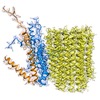
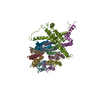


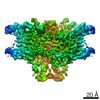

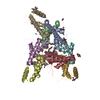




 Z (Sec.)
Z (Sec.) Y (Row.)
Y (Row.) X (Col.)
X (Col.)





















